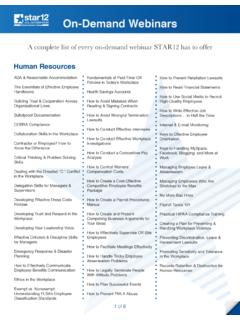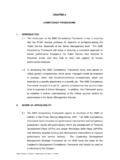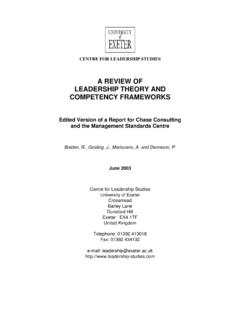Transcription of Prosci’s top-10 action steps for managing resistance
1 Prosci Change Management Process Phase 2 managing change Prosci s top-10 action steps for managing resistance The methods listed below are intended to help create desire in employees. The first step before using any of the methods suggested below is to ensure that each employee is aware of the need for change as discussed in the ADKAR model. This is a prerequisite before addressing an employee's desire to support and participate in a change. Part of building awareness around the need for change is ensuring that business leaders have created an urgency for change with employees. This is part of sharing why the change is needed and what is the risk of not changing.
2 The methods provided here are techniques that have been demonstrated to work by other organizations. However, it is not a "one-size-fits-all" approach. The combination of a specific change, a specific organization and each unique employee will result in a course of action that is unique to each person and the situation. In addition, some employees are motivated by positive opportunities, while others are motivated by avoidance of negative consequences. Carefully choose the right approach for your situation. Method 1 - Listen and understand objections Method 2 - Focus on the "what" and let go of the "how" Method 3 - Remove barriers Method 4 - Provide simple, clear choices and consequences Method 5 - Create hope Method 6 - Show the benefits in a real and tangible way Method 7 - Make a personal appeal Method 8 - Convert the strongest dissenters Method 9 - Create a sacrifice Method 10 - Use money or power Prosci.
3 Used with permission under license from Prosci Change Management Process Phase 2 managing change Method 1 - Listen and understand objections A critical step any manager should take when creating desire to change is to listen. The power of true listening and empathy is often underestimated. In many cases employees simply want to be heard and to voice their objections. Understanding these objections can often provide a clear path toward resolution. Listening can also help managers identify misunderstandings about the change. Rumors and background conversation often produce incorrect messages and wrong perceptions. Only through listening can managers identify these wrong perceptions and provide a correct and clear story about the change.
4 Caution: When engaging in this process, managers should avoid debating or arguing with employees. The goal is to listen and understand, and provide clarity about the change. Method 2 - Focus on the "what" and let go of the "how" In some types of changes, it is effective for managers to let go of the "how" and simply communicate "what" needs to change. This process transfers ownership of the solution to employees. Managers can share a clear vision of the end state, along with specific goals and timelines with employees. Employees then take on the task of achieving that vision. Employee involvement and ownership naturally builds desire to support the change, and ensures that employee objections are addressed in their solution.
5 This technique is especially useful in small groups or departments in which the change falls within the scope of that group, and has little or no impact on other groups or departments. Caution: If any combination of the following characteristics is present, then this process is more difficult to implement: a change becomes significantly large such that cross-department coordination and design is required the total number of employees is sufficiently large that they all cannot reasonably be involved in and take ownership of the design the design of the future state is already pre-determined and cannot be changed the change is dramatic and is happening quickly Attempts to simulate employee participation through interviews, focus groups and other channels of collecting input from large groups of employees can backfire.
6 Employee input does not equal employee ownership of the change. Input from employees is a good and necessary process, but will not necessarily create a desire to change when direct involvement and ownership are absent. Prosci. Used with permission under license from Prosci Change Management Process Phase 2 managing change Method 3 - Remove barriers Desire to change can be inhibited by obstacles or barriers. These barriers may relate to family, personal issues, physical limitations or money. The first step when using this method is to have followed Method 1 so that you fully understand the individual situation with this employee.
7 What may appear to be resistance or objections to the change may be disguised barriers that the employee cannot see past. Identify the barriers clearly. Determine ways that the business may be able to address these barriers. For example, if a change involves assigning a manager to a new location that requires commuting 2-hours each way, then a barrier for this manager may be a son or daughter who does not want to leave their current school (nor does the parent wish to miss the activities of their child). By allowing this manager to arrange a home office for two or three days each week, then the barrier to change related to family impact may be removed. Method 4 - Provide simple, clear choices and consequences Building desire is ultimately about choice.
8 Managers can facilitate this process by being clear about the choices employees have during change. In many cases, the actual change may be out of the control of front-line supervisors and managers. In these cases, it is very important that managers communicate in simple and clear terms what the choices and consequences are for each employee. The City of Denver, Colorado, recently began one of the largest road construction projects in the state to widen the primary interstate highway that runs through the city. This project is called T-Rex. The design and building process were carefully planned many years before construction actually began. The construction crews on this project did not have control over the final design nor the construction sequence.
9 Commuters certainly did not have control. However, this project was a role model for managing complex change. In this case the citizens of Denver and the surrounding areas were those impacted by the change. The project team created an ongoing communication campaign involving TV, radio and other media to: 1. Let people know what would happen and when. 2. Provide alternate routes and choices for commuting into Denver. 3. Share the consequences of taking certain routes at certain times, including providing ongoing information about the expected delays along each route. In this example, the change was going to happen no matter what. Yet, by communicating the choices to commuters and the potential consequences of each choice, some degree of control is given back to these commuters.
10 That is also true of changes at work. Even when the change is defined and outside of local control, by providing simple and clear choices along with the consequences of those choices, you can put the ownership and control back into the hands of employees. Prosci. Used with permission under license from Prosci Change Management Process Phase 2 managing change Method 5 - Create hope Many people will respond to the opportunity for a better future. They want to have hope. Managers can create desire to change by sharing their passion for change, creating excitement and enthusiasm, and creating hope in a better future for employees and for the organization.




